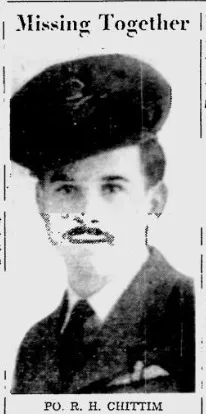Chittim, Richard Hugh
Killed in Action 1945-01-02


Birth Date: 1924
Born:
Gordon Aiken Chittim & Freida June White Chittim
Home: Windsor, Ontario (parents)
Enlistment:
Enlistment Date: Unknown
Service
RCAF
Unit
166 (B) Sqn- Squadron (RAF)
Tenacity
Base
RAF Kirmington
Rank
Pilot Officer
Position
Pilot Officer
Service Numbers
J/90196
Target
 Nuremberg Germany
Nuremberg Germany
First Burial
 War Cemetery At Durnbach, Germany
War Cemetery At Durnbach, Germany
Took off from Kirmington at 14:55 in Lancaster Mk III (Sqn code AS-M Bomber Command) on an operation to Nuremberg Germany.
Aircraft shot down (means not found) and crashed at Gmund am Tegernsee, Landkreis Miesbach, Bavaria, Germany.
Killed includes Chittim:Sergeant William Joseph Morgan RCAF R/274063 KIA Durnbach War Cemetery Coll. grave 5. C. 5-8.Flight Sergeant Roy Styan Brown RAF KIA Durnbach War Cemetery Coll. grave 5. C. 5-8.WO George Henry Pearson RAF KIA Durnbach War Cemetery Coll. grave 5. C. 5-8.Sergeant John Perry RAF KIA Durnbach War Cemetery Coll. grave 5. C. 5-8.Sergeant Jack David Jules Lucien Tarlton RAF KIA Durnbach War Cemetery Coll. grave 5. C. 5-8.
POW:Sergeant John Carl Lillis RCAF R/274162 POW camp not listed.
Lancaster ND635
Avro Lancaster

Canadian Warplane Heritage Museum
The Avro Lancaster is a British Second World War heavy bomber. It was designed and manufactured by Avro as a contemporary of the Handley Page Halifax, both bombers having been developed to the same specification, as well as the Short Stirling, all three aircraft being four-engined heavy bombers adopted by the Royal Air Force (RAF) during the same wartime era.
The Lancaster has its origins in the twin-engine Avro Manchester which had been developed during the late 1930s in response to the Air Ministry Specification P.13/36 for a capable medium bomber for "world-wide use". Originally developed as an evolution of the Manchester (which had proved troublesome in service and was retired in 1942), the Lancaster was designed by Roy Chadwick and powered by four Rolls-Royce Merlins and in one version, Bristol Hercules engines. It first saw service with RAF Bomber Command in 1942 and as the strategic bombing offensive over Europe gathered momentum, it was the main aircraft for the night-time bombing campaigns that followed. As increasing numbers of the type were produced, it became the principal heavy bomber used by the RAF, the Royal Canadian Air Force (RCAF) and squadrons from other Commonwealth and European countries serving within the RAF, overshadowing the Halifax and Stirling. Wikipedia
166 (B) Sqn Tenacity (Huddersfield's Own)
No 166 Squadron RAF was originally formed at Bircham Newton, Norfolk on June 13, 1918, designed as a heavy bomber unit, to fly the Handley Page V/1500 aircraft. The squadron was never fully mobilized because the Armistice intervened. The squadron was re-formed in November 1936 as a heavy bomber unit, flying Handley Page Heyfords, later equipping with Armstrong Whitworth Whitleys. It was based at Boscombe Down, Wiltshire from November 1936 to January 1937, when it moved to Leconfield, Yorkshire. The squadron became part of an air observer's school on June 7, 1938, and then became a 1 Group pool squadron in May 1939. From September 1939 it was based at Abingdon, Berkshire until April 1940. In that month the squadron merged with no. 97 Squadron to form No. 10 OTU.
In January 1943 the squadron was re-formed at Kirmington, Yorkshire (53.578,-0.344, now Humberside Airport), from flights of Nos. 150 and 170 squadrons, when parts of these squadrons were posted to the Middle East. It was again bomber squadron, flying Vickers Wellingtons in No. 1 Group of Bomber Command. It remained at Kirmington until the end of WWII, later re-equipping with Avro Lancasters. In the period 27/28 January 1943 and 25 April 1945, it dropped 27,287 tons of bombs and laid 333 tons of mines. The squadron won "at least" 2 DSOs, 2 CGMs, 117 DFCs and 108 DFMs in the course of WWII. The squadron was disbanded on November 18, 1945.
 Canadian Virtual War Memorial
Canadian Virtual War Memorial Commonwealth War Graves Commission
Commonwealth War Graves Commission www.findagrave.com
www.findagrave.com

 Lancaster Bomber
Lancaster Bomber Wikipedia
Wikipedia Harold A Skaarup Web Page
Harold A Skaarup Web Page